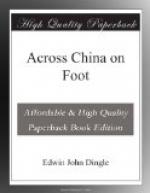Lao-wa-t’an is the most important point on the route. One of the largest Customs stations in the province of Yuen-nan is here situated at the east end of a one-span suspension bridge, about one hundred and fifty feet in length. No ponies carrying loads are allowed to cross the bridge, the roads east of this being unfit for beasts of burden. There is then a fearful climb to a place called Teo-sha-kwan, a stage of only sixty li. The reader should not mentally reduce this to English miles, for the march was more like fifty miles than thirty, if we consider the physical exertion required to scale the treacherous roads. Over a broad, zigzagging, roughly-paved road, said to have no less than ninety-eight curves from bottom to top, we ascend for thirty li, and then descend for the remainder of the journey through a narrow defile along the northern bank of the river, the opposite side being a vertical sheet of rock rising to at least a thousand feet sheer up, very similar to the gorges of the Mekong at the western end of the province, which I crossed in due course.
To Ch’i-li-p’u, high up on the mountain banks, the first twenty-five li is by the river. At the half-way place a fearful ascent is experienced, the most notable precipice on the route between Sui-fu and Yuen-nan-fu, up a broad zigzag path, and as I sat at dinner I could see neither top nor bottom owing to the overhanging masses of rock: this is after having negotiated an ascent quite as steep, but smaller. To Ta-kwan-hsien a few natural obstacles occur, although the road is always high up on the hill-sides. I crossed a miserable suspension bridge of two spans. The southern span is about thirty feet, the northern span eighty feet; the center is supported by a buttress of splendid blocks of squared stone, resting on the rock in the bed of the river, one side being considerably worn away by the action of the water. The longer span was hung very slack, the woodwork forming the pathway was not too safe, and the general shaky appearance was particularly uninviting.
From Ta-kwan-hsien to Wuchai is steady pulling. Once in an opening in the hill we passed along and then ascended an exceedingly steep spur on one side of a narrow and very deep natural amphitheatre, formed by surrounding mountains. We then came to a lagoon, and eventually the brow of the hill was reached. Thus the Wuchai Valley is arrived at, where, owing to a collection of water, the road is often impassable to man and beast. Often during the rainy season there is a lagoon of mud or water formed by the drainage from the mountains, which finds no escape but by percolating through the earth and rock to a valley on the east of, and below, the mountains forming the eastern boundary of the Wuchai Valley. To Chao-t’ong is fairly level going.




